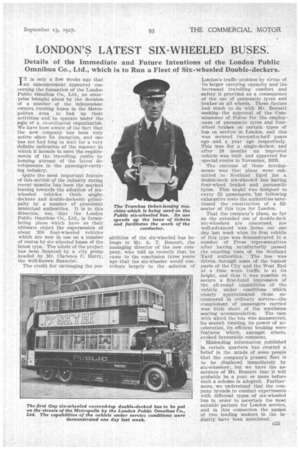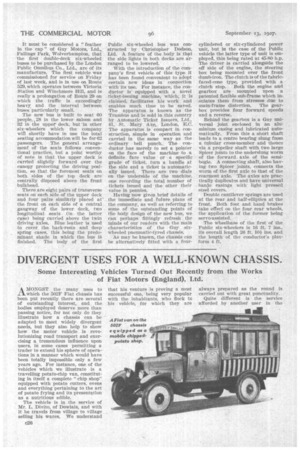LONDON'S LATEST SIX-WHEELED BUSES.
Page 47

Page 48

If you've noticed an error in this article please click here to report it so we can fix it.
Details of the Immediate and Future Intentions of the London Public Omnibus Co., Ltd., which is to Run a Fleet of Six-wheeled Double-deckers.
IT is only a few weeks ago that an announcement appeared concerning the formationof the London -Public Omnibus Co:, Ltd., an enter-prise brought about by the decision of a number of the independent owners running buses in the Metropolitan area to link up • their activities and to operate under the as Of a co-ordinated organization. We have been aware of the fact that the new coinpany has been very active since its inception, and one has not had long to wait for a very -definite indication of the manner in which it intends to meet the requirements of the travellingpublic by keeping abreast of the latest developments in the passenger-carrying industry.
Quite the most important feature of this section of the industry during
• recent -months' has been the marked -leaning towards the adoption of sixwheeled vehicles (both singledeckers and double-deckers) principally by a number of prominent municipal authorities. It is in this direction, -too, that the London 'Public Omnibus Co:, Ltd., is formulating plans which have as their ultimate object the supersession of about 200 four-wheeled vehicles which are now in use on a number of routes by six-wheeled buses of the ,latest type. The whole of the project has been financed by a city group headed by Mr. Clarence C. 1-latry, the well-known financiei.
The credit for envisaging the pee
sibilities of the six-wheeled bus belongs to Mr. A. T. Bennett, the managing direetor of the new company, who told us recently that he , came to the conclusion three yearsagO that the six-wheeler would contribute largely to the solution of
London's traffic problem by virtue of its larger carrying capacity and the. increased travelling comfort and safety it provided as a conseqUence of the use of pneumatic tyres and brakes on all wheels. These factors had much to do with Mr. Bennett Seeking the approval of the Commissioner of Police for the employment of pneumatic tyres and fourwheel brakes on certain types of bus on service in London, and this was secured two-and-a-half years ago and d year ago respectively. This was for a single-decker, and after 18 months an improYed vehicle was built and approved for special routes in November, 1926.
The outcome of these developments was that plans were submitted to Scotland Yard for a double-deck six-wheeled bus having four-wheel braked and pneumatic tyres. This moitel was designed to carry 52 passengers, but following exhaustive tests the authorities kl.nctioned the construction of a 62seater of this type for London.
That the company's plans, so far as the extended use of double-deck six-wheelers are concerned, are well-advanced was borne out one day last week when its first vehicle of this type was demonstrated to •a number of Press representatives after having Satisfactorily passed the exacting tests of the Scotland Yard authorities. The bus was driven, through some of the busiest parts of the City and the West End at a time when traffic is at its height, and thus it was possible to secure a first-hand impression of the all-round • capabilities of the vehicle under conditions which closely approximated those encountered in ordinary service—the complement of passengers carried was little short, of the maximum seating accommodation. The ease with which the bus was manceuvred, its smooth running, its power of acceleration, its efficient braking were features which, amongst others, evoked, favourable comment.
Misleading information published in certain quarters has created a belief in the minds of sonic people that the company's present fleet is to be displaced immediately by six-wheelers; but we have the assurance of Mr. Bennett that it will probably he a year or more before such a scheme is adopted. Furthermore, we understand that the company intends to conduct experiments with different types of six-wheeled bus in order to ascertain the most suitable pattern for London service, and in this connection the names of two leading makers in the industry have been Mentioned.
• It must be considered a "feather in the cap" of Guy Motors, Ltd., Fallings Park, Wolverhampton, that the first double-deck six-wheeled buses to be purchased by the London Public Omnibus Co., Lid., are of its manufacture. The first vehicle was commissioned for service on Friday of last week, and is in use on Route. 529, which operates between Victoria -Station and Winchmore Hill, and is really a prolongation of Route 29 on which the traffic is exceedingly heavy. and the interval between buses particularly small.
The new bus is built to seat 60 people„ 28 in the lower saloon and 32 in the tippet deck, but In other six-wheelers which the company will shortly have in use the total seating accommodation will be for 62 passengers. The general arrangement of the seats follows conventional practice, but a point worthy of note is that the upper deck is carried slightly forward over the canopy protecting the driving position, so that the foremost seats on both sides of the top deck are centrally disposed above the front bulkhead.
There are eight pairs of transverse seats on each side of the upper deck and four pains similarly placed at' the front on each side of a central• gangway of the lower deck, two longitudinal seats (in the latter case) being carried above the twin driving axles. Blue leather is used to cover the back-rests and deep spring cases, this .being the predominant shade in which the bus iS finished. The body of the first Public six-wheeled bus was con' structed by Christopher Dodson, Ltd. A feature of the body isjhat the side lights in both decks are ar
rangedto be lowered. •
With the introduction of the company's first vehicle of this type_ it has been found convenient to adopt certain new ideas in connection with its use. For instance, the conductor is equipped with a novel ticket-issuing machine, which, it is claimed, facilitates his work and enables much time to he saved. The: apparatus is known as the .Traintais and is sold in this country by Automatic Ticket Issuers, Ltd., 41, St. Mary Axe, London, E.C. The apparatus is compact in construction, simple -in operation and carried in the same way as the ordinary bell punch.. The conductor has merely to set a pointer on the face of the machine to a definite fare value or a specific grade of ticket, turn a handle at the side and a ticket is automatically issued. There are two dials on the underside of the machine one recording the total number of tickets issued and the other their value in pennies.
Having now given brief details of the immediate and future plans of the company, as well as referring to Some of the outstanding points of the body design of the new bus, we can perhaps fittingly refresh the minds of our readera with the main characteristics of . the Guy sixwheeled pneumatic-tyred chassis.
• As may be known, the chassis can be alternatively fitted with a four cylindered or six-cylindered power unit, but in the case a the Public vehicle the latter type of unit is employed, this being rated at 45-80• h.p. The driver is carried alongside the off side of the engine, the steering box being mounted over the front dumb-iron. The clutch is of the fabricfaced-cone type, provided with a clutch stop. Both the engine and gearbox are mounted upon a patented flexible sub-frame which insulates them -from stresses due to main-frame distortion. The gearbox provides four forward speeds and a reverse.
Behind the gearbox is a Guy tint: versa! joint enclosed, in an aluminium casing and lubricated automatically. From this a short shaft leads to a centre bearing slung from a tubular cross-member and thence via a propeller shaft with two large Spicer joints to the untierslung worm of the forward. axle of the semibogie. A connecting shaft, also having two Spicer joints, connects the worm of the first axle to that of the rearmost axle. The axles are practically duplicates and have universal banjo casings with light pressed steel covers.
Double cantilever springs are used at the rear and half-elliptic at the front. Both foot and hand brakes take effect on the four rear wheels, the application of the former being servo-assisted.
The wheelbase of the first of the Public six-wheelers is 16 ft. 7 ins., its overall length 26 ft. 10iins, and the length of the conductor's platform 4 ft.












































































































